Search the Special Collections and Archives Portal
Search Results
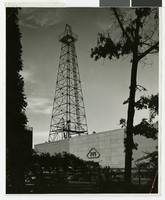
Photograph of the exterior of Hughes Research Laboratories, Culver City, California, circa 1940s
Date
1940 to 1949
Archival Collection
Description
The exterior of Hughes Research Laboratories where rock bits were test-drilled in Culver City, California in the 1940s. Transcribed from note taped to back of photo: "Rock bits are test-drilled in the laboratory under conditions that duplicate, as far as is possible in the laboratory, those encountered in actual drilling. As a result, rotational speeds, loads, and fluid volume are closely controlled. The rig operator occupies a splash-proof booth above the 'cellar floor.' The instruments on his control panel provide for application and measurement of variable axial loading on the drilling bit up to 100,000 lbs., variable rotational speeds up to 400 rpm, measurement of bit penetration over a total vertical travel of 5 feet at rates up to 180 ft. per hour, and torque. On the panel, also, are several controls for the operation of mud pump and other accessory equipment."
Image
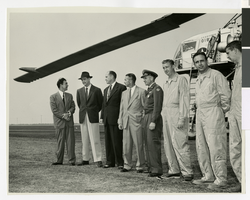
Photograph of Howard Hughes and others with the XH-17 helicopter, Culver City, California, October 23, 1952
Date
1952
Archival Collection
Description
Howard Hughes (second from left) standing in front of the experimental helicopter XH-17, Flying Crane, with others (from left to right): Rea Hopper, Director of the Aeronautical Division, Hughes Aircraft Company; Hughes; Clyde Jones, Director of Engineering, Hughes Tool Company Aeronautical Division; Warren Reed, Assistant; Colonel Carl E. Jackson from Air Research and Development Headquarters, Baltimore; Gale J. Moore, Pilot; possibly Chal Bowen, Flight Engineer/Co-pilot, and an unidentified man, on October 23, 1952.
Image
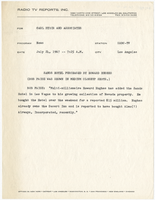
Press release announcing Howard Hughes' purchase of the Sands Hotel
Date
1967-07-24
Description
Press release quoting Bob Paige announcing Howard Hughes' acquistion of the Sands Hotel in Las Vegas.
Text
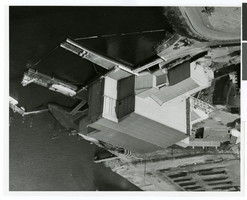
Aerial view of Hughes Helicopters Division of Summa Corporation, Culver City, California, circa late 1950s
Date
1957 to 1959
Archival Collection
Description
Hughes Helicopters Division of Summa Corporation in Culver City, California.
Image
Trinity Church and lower Manhattan from Financial District, New York City, New York: panoramic photograph, 1981 May 24
Level of Description
Item
Archival Collection
Bob Paluzzi Panoramic Photographs
To request this item in person:
Collection Number: PH-00414
Collection Name: Bob Paluzzi Panoramic Photographs
Box/Folder: Box 07, Digital File 00
Collection Name: Bob Paluzzi Panoramic Photographs
Box/Folder: Box 07, Digital File 00
Archival Component
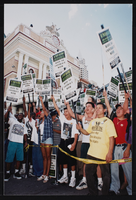
New York, New York ARK rally, Culinary Union, Las Vegas (Nev.), 1997 May 30 (folder 1 of 9), image 15
Date
1997-05-30
Description
Arrangement note: Series I. Demonstrations, Subseries I.B. Other Demonstrations and Strikes
Image
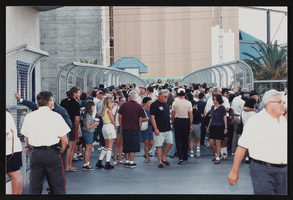
New York, New York ARK rally, Culinary Union, Las Vegas (Nev.), 1997 May 30 (folder 8 of 9), image 15
Date
1997-05-30
Description
Arrangement note: Series I. Demonstrations, Subseries I.B. Other Demonstrations and Strikes
Image
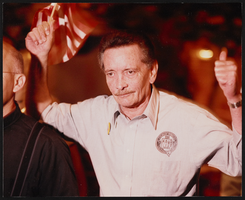
New York, New York ARK rally, Culinary Union, Las Vegas (Nev.), 1997 May 30 (folder 6 of 9), image 15
Date
1997-05-30
Description
Arrangement note: Series I. Demonstrations, Subseries I.B. Other Demonstrations and Strikes
Image
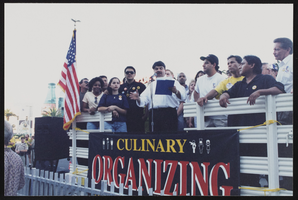
New York, New York ARK rally, Culinary Union, Las Vegas (Nev.), 1997 May 30 (folder 4 of 9), image 15
Date
1997-05-30
Description
Arrangement note: Series I. Demonstrations, Subseries I.B. Other Demonstrations and Strikes
Image
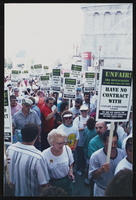
New York, New York ARK rally, Culinary Union, Las Vegas (Nev.), 1997 May 30 (folder 5 of 9), image 15
Date
1997-05-30
Description
Arrangement note: Series I. Demonstrations, Subseries I.B. Other Demonstrations and Strikes
Image
Pagination
Refine my results
Content Type
Creator or Contributor
Subject
Archival Collection
Digital Project
Resource Type
Year
Material Type
Place
Language
Records Classification
